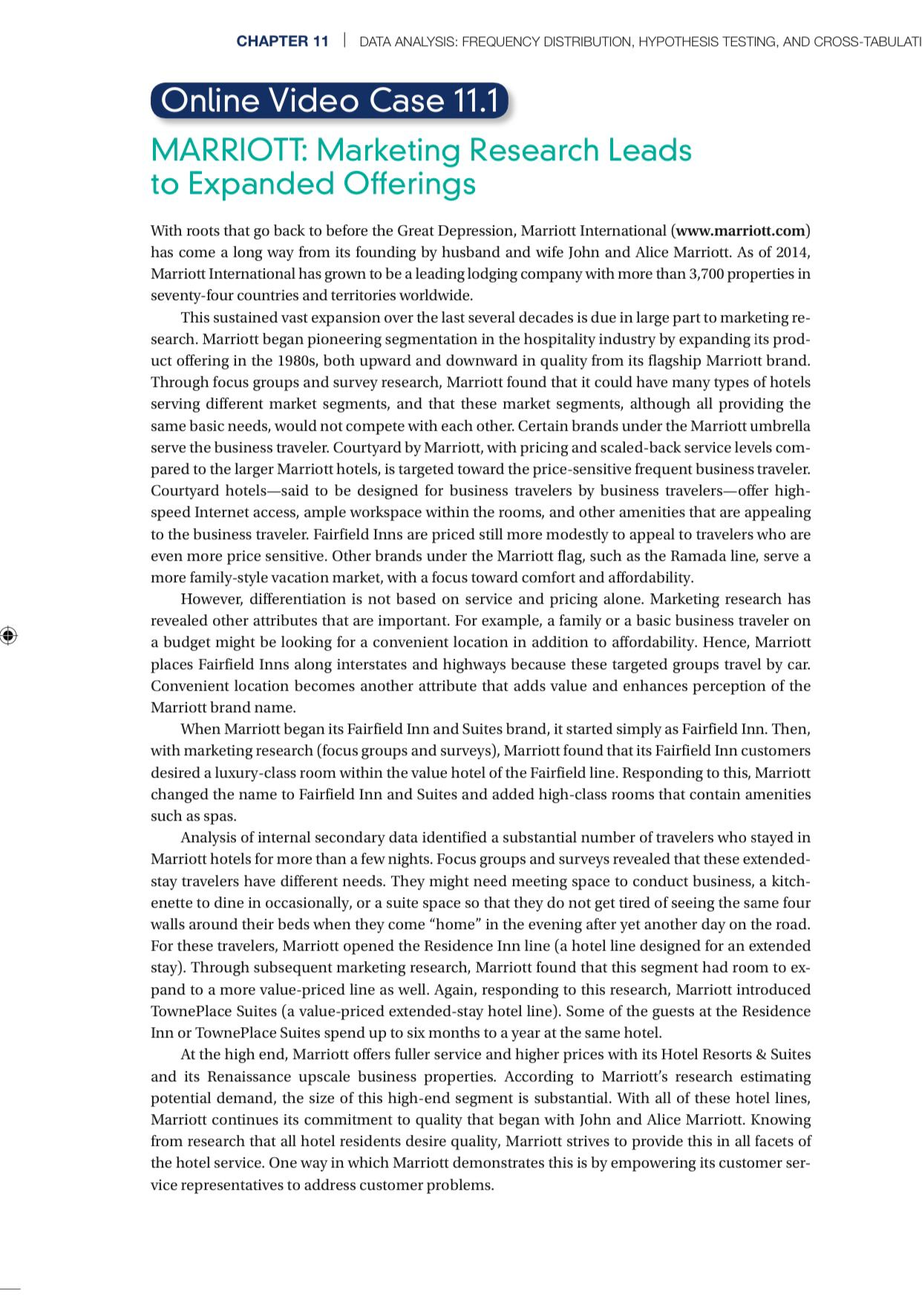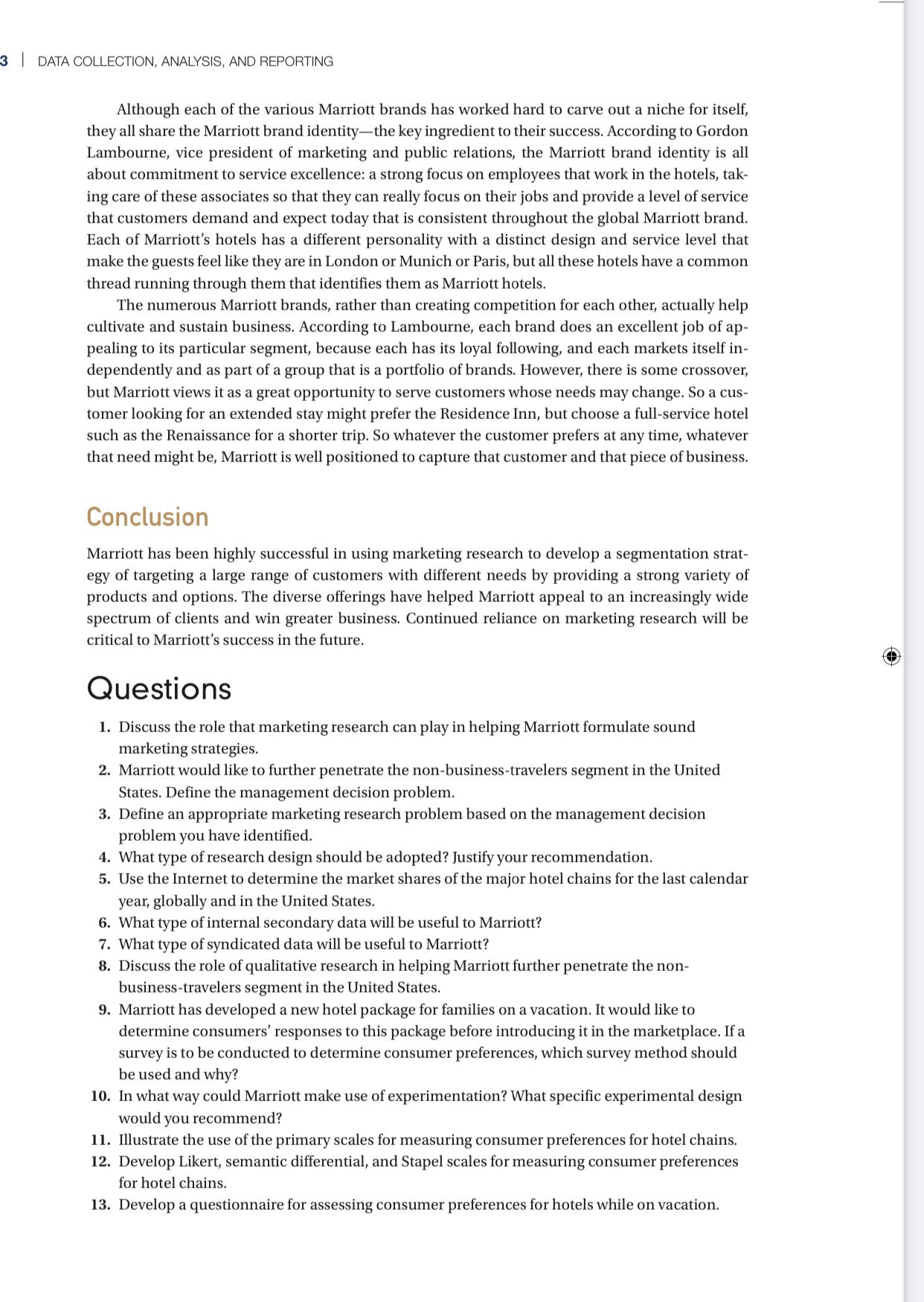using the attached image kindly answer the questions in the image
CHAPTER 11 | DATA ANALYSIS: FREQUENCY DISTRIBUTION. HYPOTi-IESIS TESTING, AND CHOSS-TABULATI Online Video Case 11.1 MARRIOTT: Marketing Research Leads to Expanded Offerings Mth roots that go back to before the Great Depression. Marriott International {www.mrriott.com) has come a long way 'om its founding by husband and wife Iohn and Alice Marriott. As of 2014. Marriott International has grown to be a leading lodging company with more than 3,700 properties in seventy-four countries and territories worldwide. This sustained vast expansion over the last several decades is due in large part to marketing re- search. Marriott began pioneering segmentation in the hospitality industry by expanding its prod- uct offering in the 19805, both upward and downward in quality from its agship Marriott brand. Through focus groups and survey research, Marriott found that it could have many types of hotels serving different market segments, and that these market segments, although all providing the same basic needs, would not compete with each other. Certain brands under the Marriott umbrella serve the business traveler: Courtyard by Marriott, with pricing and scaled-back service levels com- pared to the larger Marriott hotels, is targeted toward the pricesensitive frequent business traveler. Courtyard hotelssaid to be designed for business travelers by business travelersoffer high- speed Internet access, ample workspace within the rooms. and other amenities that are appealing to the business traveler. Fairfield Inns are priced still more modestly to appeal to travelers who are even more price sensitive. Other brands under the Marriott ag, such as the Ramada line, serve a more family-style vacation market, with a focus toward comfort and affordability. However, differentiation is not based on service and pricing alone. Marketing research has revealed other attributes that are important. For example, a family or a basic business traveler on a budget might be looking for a convenient location in addition to affordability. Hence, Marriott places Faireld Inns along interstates and highways because these targeted groups travel by car. Convenient location becomes another attribute that adds value and enhances perception of the Marriott brand name. When Marriott began its Faireld Inn and Suites brand, it started simply as Faireld Inn. Then. with marketing research (focus groups and surveys). Marriott found that its Faireld Inn customers desired a luxury-class room within the value hotel of the Faireld line. Responding to this. Marriott changed the name to Faireld Inn and Suites and added high-class rooms that contain amenities such as spas. Analysis of internal secondary data identified a substantial number of travelers who stayed in Marriott hotels for more than a few nights. Focus groups and surveys revealed that these extended- stay travelers have different needs. They might need meeting space to conduct business, a kitch- enette to dine in occasionally, or a suite space so that they do not get tired of seeing the same four walls around their beds when they come "home" in the evening after yet another day on the road. For these travelers, Marriott opened the Residence Inn line {a hotel line designed for an extended stay). Through subsequent marketing research. Marriott found that this segment had room to ex- pand to a more value-priced line as well. Again, responding to this research, Marriott introduced TownePlace Suites (a value-priced extended-stay hotel line). Some of the guests at the Residence Inn or TownePlace Suites spend up to six months to a year at the same hotel. At the high end, Marriott offers fuller service and higher prices with its Hotel Resorts 8: Suites and its Renaissance upscale business properties. According to Marriott's research estimating potential demand, the size of this high-end segment is substantial. With all of these hotel lines, Marriott continues its commitment to quality that began with John and Alice Marriott. Knowing from research that all hotel residents desire quality, Marriott strives to provide this in all facets of the hotel service. One way in which Marriott demonstrates this is by empowering its customer ser- vice representatives to address customer problems. 3 l DATA COLLECTION. ANALYSIS. AND REPORTING Although each of the various Marriott brands has worked hard to carve out a niche for itself, they all share the Marriott brand identitythe key ingredient to their success. According to Gordon Lambourne, vice president of marketing and public relations, the Marriott brand identity is all about commitment to service excellence: a strong focus on employees that work in the hotels, tak- ing care of these associates so that they can really focus on their jobs and provide a level of service that customers demand and expect today that is consistent throughout the global Marriott brand. Each of Marriott's hotels has a different personality with a distinct design and service level that make the guests feel like they are in London or Munich or Paris, but all these hotels have a common thread running through them that identies them as Marriott hotels. The numerous Marriott brands, rather than creating competition for each other, actually help cultivate and sustain business. According to Lambourne, each brand does an excellent job of ap- pealing to its particular segment, because each has its loyal following, and each markets itself in- dependently and as part of a group that is a portfolio of brands. However, there is some crossover, but Marriott views it as a great opportunity to serve customers whose needs may change. So a cus- tomer looking for an extended stay might prefer the Residence Inn, but choose a full-service hotel such as the Renaissance for a shorter trip. So whatever the customer prefers at any time, whatever that need might be, Marriott is well positioned to capture that customer and that piece of business. Conclusion Marriott has been highly successful in using marketing research to develop a segmentation strat- egy of targeting a large range of customers with different needs by providing a strong variety of products and options. The diverse offerings have helped Marriott appeal to an increasingly wide spectrum of clients and win greater business. Continued reliance on marketing research will be critical to Marriott's success in the future. Questions 1. Discuss the role that marketing research can play in helping Marriott formulate sound marketing strategies. 2. Marriott would like to further penetrate the non-business-travelers segment in the United States. Define the management decision problem. 3. Define an appropriate marketing research problem based on the management decision problem you have identied. 4. What type of research design should be adopted? Iustify your recommendation. 5. Use the Internet to determine the market shares of the major hotel chains for the last calendar year, globally and in the United States. 6. What type of internal secondary data will be useful to Marriott? 7. What type of syndicated data will be useful to Marriott? 8. Discuss the role of qualitative research in helping Marriott further penetrate the non- businesstravelers segment in the United States. 9. Marriott has developed a new hotel package for families on a vacation. It would like to determine consumers' responses to this package before introducing it in the marketplace. If a survey is to be conducted to determine consumer preferences, which survey method should be used and why? 10. In what way could Marriott make use of experimentation? What specic experimental design would you recommend? 11. Illustrate the use of the primary scales for measuring consumer preferences for hotel chains. 12. Develop Likert, semantic differential, and Stapel scales for measuring consumer preferences for hotel chains. 13. Develop a questionnaire for assessing consumer preferences for hotels while on vacation








